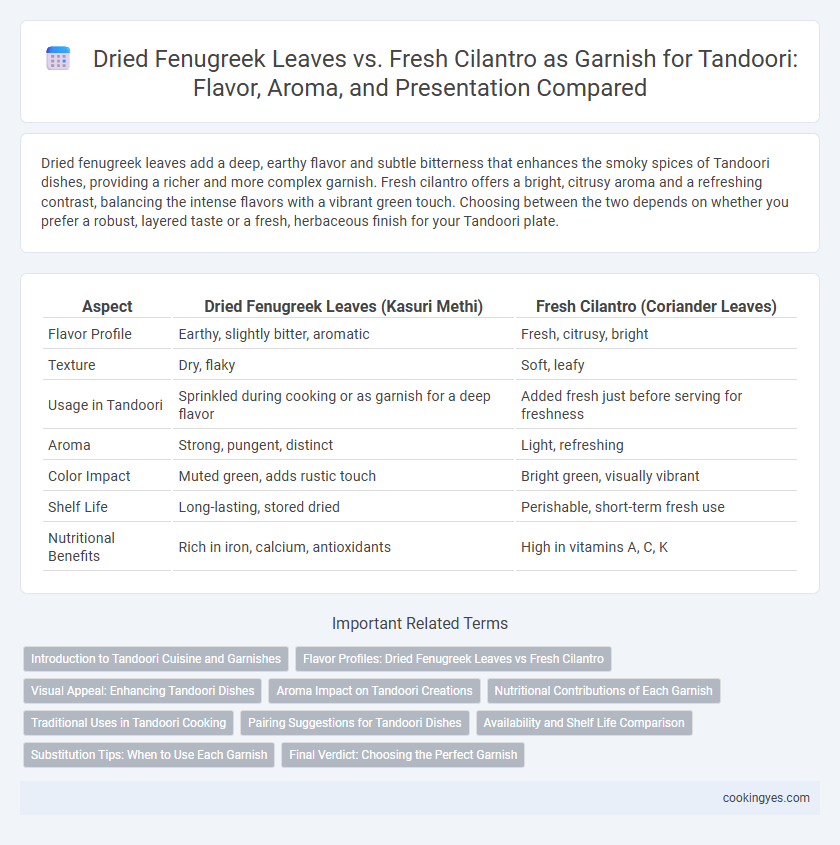Dried fenugreek leaves add a deep, earthy flavor and subtle bitterness that enhances the smoky spices of Tandoori dishes, providing a richer and more complex garnish. Fresh cilantro offers a bright, citrusy aroma and a refreshing contrast, balancing the intense flavors with a vibrant green touch. Choosing between the two depends on whether you prefer a robust, layered taste or a fresh, herbaceous finish for your Tandoori plate.
Table of Comparison
| Aspect | Dried Fenugreek Leaves (Kasuri Methi) | Fresh Cilantro (Coriander Leaves) |
|---|---|---|
| Flavor Profile | Earthy, slightly bitter, aromatic | Fresh, citrusy, bright |
| Texture | Dry, flaky | Soft, leafy |
| Usage in Tandoori | Sprinkled during cooking or as garnish for a deep flavor | Added fresh just before serving for freshness |
| Aroma | Strong, pungent, distinct | Light, refreshing |
| Color Impact | Muted green, adds rustic touch | Bright green, visually vibrant |
| Shelf Life | Long-lasting, stored dried | Perishable, short-term fresh use |
| Nutritional Benefits | Rich in iron, calcium, antioxidants | High in vitamins A, C, K |
Introduction to Tandoori Cuisine and Garnishes
Dried fenugreek leaves, also known as kasuri methi, impart a deep, slightly bitter aroma essential to authentic tandoori dishes, enhancing the smoky spices that define this Indian culinary tradition. Fresh cilantro offers a bright, citrusy contrast that adds vibrant color and freshness to the rich, marinated meats typically cooked in a tandoor oven. Both garnishes play crucial roles in balancing flavors, with dried fenugreek leaves intensifying earthiness and fresh cilantro providing a refreshing finish in tandoori cuisine presentations.
Flavor Profiles: Dried Fenugreek Leaves vs Fresh Cilantro
Dried fenugreek leaves offer a robust, slightly bitter, and earthy flavor with a hint of sweetness that complements the smoky, spiced notes of Tandoori dishes. Fresh cilantro provides a bright, citrusy, and herbaceous taste, adding a refreshing contrast to the rich, charred flavors typical of Tandoori cooking. Choosing dried fenugreek leaves enhances depth and warmth, while fresh cilantro introduces a vibrant, clean finish to the garnish.
Visual Appeal: Enhancing Tandoori Dishes
Dried fenugreek leaves create a deep, earthy green contrast on tandoori dishes, enhancing their rustic and authentic appearance. Fresh cilantro offers vibrant, bright green hues that add a lively, fresh finish, making the dish visually inviting. Using dried fenugreek emphasizes traditional warmth, while fresh cilantro provides a crisp, colorful accent for a balanced visual appeal.
Aroma Impact on Tandoori Creations
Dried fenugreek leaves (kasuri methi) provide a strong, slightly bitter aroma that enhances the smoky and spicy flavors of tandoori dishes, adding depth and earthiness. Fresh cilantro offers a bright, citrusy fragrance that lightens the rich, robust tandoori marinade, delivering a fresh contrast to the intense spices. Choosing between dried fenugreek leaves and fresh cilantro for garnish directly influences the aromatic profile and overall sensory experience of tandoori creations.
Nutritional Contributions of Each Garnish
Dried fenugreek leaves offer a rich source of iron, fiber, and antioxidants, enhancing the nutritional profile of Tandoori dishes with essential micronutrients. Fresh cilantro provides high levels of vitamin K, vitamin A, and vitamin C, contributing to immune support and anti-inflammatory benefits. Both garnishes complement Tandoori by adding unique vitamins and minerals that support digestion and overall health.
Traditional Uses in Tandoori Cooking
Dried fenugreek leaves (kasuri methi) impart a distinct earthy bitterness and are traditionally used in tandoori cooking to enhance the deep smoky flavors of marinated meats and vegetables. Fresh cilantro offers a bright, citrusy freshness commonly sprinkled over finished tandoori dishes to balance the spices and add visual appeal. Both garnishes serve unique roles, with fenugreek leaves intensifying flavor complexity and fresh cilantro providing aromatic contrast in classic tandoori recipes.
Pairing Suggestions for Tandoori Dishes
Dried fenugreek leaves, known as kasuri methi, impart a smoky, earthy flavor that complements the robust spices of tandoori dishes, enhancing the charred aroma typical of traditional tandoori cooking. Fresh cilantro provides a bright, citrusy contrast that balances the intense heat and offers a refreshing finish to grilled meats and vegetables. Pair dried fenugreek leaves with richer tandoori items like chicken tikka or paneer for depth, while fresh cilantro works well with lighter dishes such as tandoori fish or vegetable kebabs for a vibrant garnish.
Availability and Shelf Life Comparison
Dried fenugreek leaves (Kasuri methi) offer extended shelf life of up to six months when stored in an airtight container, making them readily available year-round for tandoori dishes. Fresh cilantro, while delivering a vibrant flavor and aroma, has limited availability depending on season and a short shelf life of about one week when refrigerated. Choosing dried fenugreek ensures consistent garnish supply, whereas fresh cilantro requires timely use for optimal freshness and taste.
Substitution Tips: When to Use Each Garnish
Dried fenugreek leaves (kasuri methi) provide a robust, slightly bitter flavor ideal for authentic tandoori dishes, making them perfect when you want a deep, earthy aroma without added moisture. Fresh cilantro offers a bright, citrusy freshness that works best as a garnish just before serving to enhance visual appeal and add a burst of herbal contrast. Substitute fresh cilantro for dried fenugreek leaves when seeking a lighter, fresher taste, but use dried fenugreek to maintain the traditional flavor profile of tandoori recipes.
Final Verdict: Choosing the Perfect Garnish
Dried fenugreek leaves (kasuri methi) offer a robust, earthy aroma that complements the smoky flavors of tandoori dishes, while fresh cilantro provides a bright, citrusy freshness that enhances overall presentation and taste. For authenticity and depth, dried fenugreek leaves are the preferred garnish, especially when sprinkled just before serving to preserve their unique flavor profile. Fresh cilantro suits those seeking a lighter, herbaceous contrast, making it ideal for a more vibrant garnish in tandoori preparations.
Dried fenugreek leaves vs Fresh cilantro for garnish Infographic

 cookingyes.com
cookingyes.com